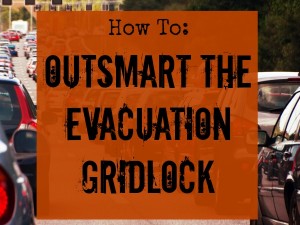 In a crisis situation, panic is the only given…
In a crisis situation, panic is the only given…
If you intend to “bug-out,” then you must hit the roads before they become gridlocked, or even shut down by authorities.
All experts agree that the first 72 hours of a crisis are the most critical. This is the time after the disaster strikes, but before aid arrives to quell the panic.
What they often leave out is that: If you intend to escape to a remote location, a cabin in the woods perhaps, you’re going to need to leave within an hour of the crisis event… within the first 20 minutes ideally.
Otherwise, you may get swept up in a traffic jam so dense and hopeless, drivers will begin to abandon their cars on the road.
So, what steps can you take in order to giver your family the chance to escape before the gridlock?
Bug-Out Bags
One of the key essentials is to compile the ultimate “Bug-Out Bag.” If you’re not familiar with the concept, a bug-out bag is a bag (usually a backpack) filled with all the items you may need to survive a crisis away from home… should you be forced to evacuate (or “bug-out”) in a hurry.
Some survivalists call these “72-hour bags” or “go-bags,” but the purpose is the same: To give you the opportunity to drop everything and leave at a moment’s notice… no packing necessary.
Each family member should have their own bug-out bag in storage, even children. This will ensure that everyone has the supplies they need to get to your destination.
Here are 8 bug-out bag essentials:
Cash – Don’t get caught in a crisis without plenty of cash, at least $100. You can’t depend on credit cards or ATMs to be functioning properly. Even if the ATM is working, it’s likely to be out of cash by the time you get to it. You may need to buy supplies, bribe officials, or pay off criminal gangs/looters.
Canteen – In a short-term survival situation, water is more important than food. A full canteen is the cornerstone of a good bug-out bag. Iodine tablets to treat and disinfect creek or pond water are also a great idea.
Food – You won’t find MREs on the menu at a fancy restaurant; they taste bland and terrible. MREs are ideal for packing the most nutrition into a small space (like a bug-out bag). Workout bars with lots of protein and calories are a good alternative, as are dehydrated, just-add-water meals.
First Aid Kit – Dozens of compact first aid kits are available online. Your kit should include a variety of bandages, gauze pads, antibiotic ointments, antiseptics, painkillers, and perhaps even a suture kit.
Warm Clothing – Warm, water-resistant clothing is ideal for your bug-out bag, since you never know what the weather may be like when you need to bug-out. Good suggestions are: thermal underwear, rain ponchos, and insulated rain jackets.
Multitool – A good multitool will be indispensable in a crisis. Choose a high quality tool with a good knife blade, so it can double as a weapon in a pinch.
Flashlight – The most important aspects of a flashlight are reliability, and operating time. Many of the brightest, most expensive flashlights draw a ton of battery power and can only run for a couple of hours. Maglite offers a good balance.
Fire Starter – There are a million ways to start a fire, and at least a dozen ways to pay over $20 for a fire starter tool. May I introduce, the Bic lighter. I recommend slipping an 8-pack into you bag.
I urge you to take the contents your bug-out bag very seriously. You may have to survive on the contents of it alone for a few days. Build your bug-out bag to last you for 72 hours.


thank you
Keep those bics contained, or in a tight pack, the lever can depress and empty the contents. Dry socks. Hat or cap. Tinder. Big handkerchief. Phone charger. Route and destination map. Liquid soap. Meds. Pistol and ammo. Mace. I.D. Water. Disinfectant. Salt. Coffee. 1 quart bucket w/bail. Cup and plate.Fork and spoon (all stainless preferably). Pen and tablet. Deet. Slicker. Compass. House and car key.
Or you may need nothing more – assuming you leave early – than road snacks, cash and a change of skivvies. Your most likely need to bug out will be a storm or flood. So you will need a motel reservation or a friend/ relative with whom you can crash for a week or so, but you won’t need to plan for the long-term.
So, maybe you need this one small bag, a larger one to get to your retreat if things get hairy, and a fully loaded crew-cab pick-up with a camper shell, equipped for off-road driving, in case of the worst scenarios. If nothing really goes too wrong, you can come back home later and hide that truck back in the garage.
Good call on the Bic lighters. It certainly wouldn’t be a bad idea to keep a magnesium fire starter in your pack as well. Then you’re not dependent on butane.
Have a paper map of the area, don’t rely on GPS. Plan some alternate routes if main routes are clogged. Know the area you live in and where you’re going.